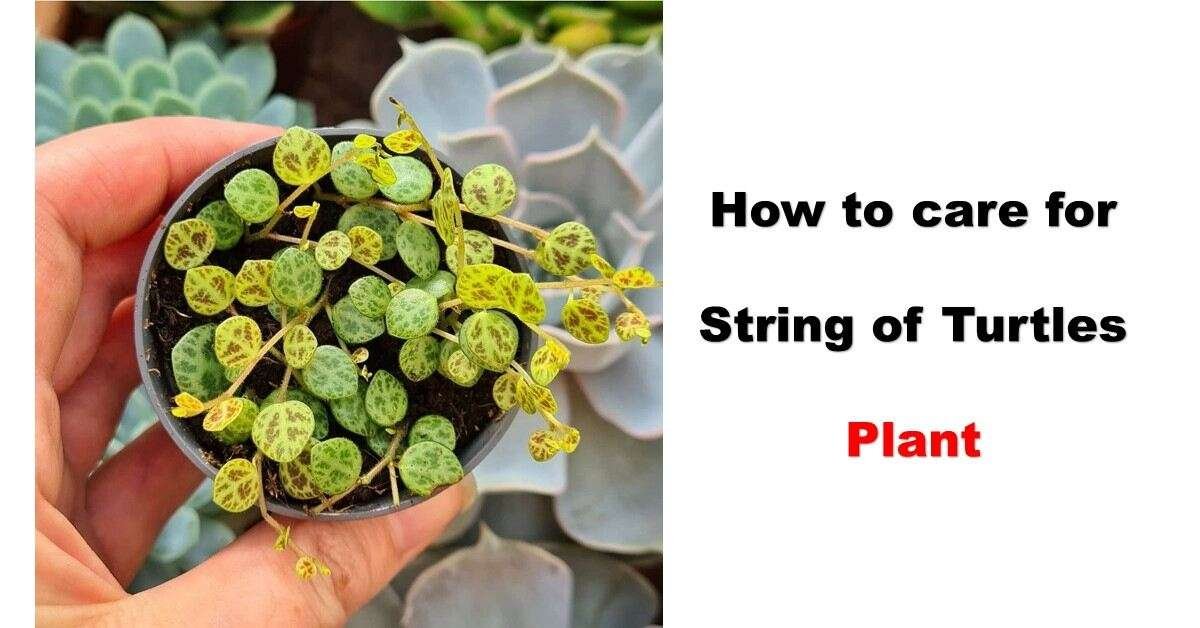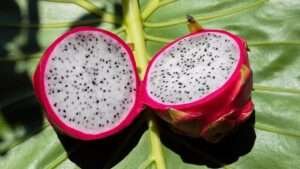What you will read in this Blog?
ToggleIntroduction to String of Turtles
The string of turtles plant is a tribute to the artistic ability of nature for those who appreciate gardens and interior greenery. Botanically known as Peperomia prostrate, the string of turtles plant is a distinctive addition to any collection of flora, named for its striking resemblance to a string of turtles against its sprawling tendrils and delicately patterned leaves. Through this plant’s calm, ritualistic maintenance, one finds a beautiful addition to their haven and a lovable character emerging inside the botanical residence.
Here, we’ll delve into the subtleties of caring for this unusual green gem, covering everything from its visual appeal to propagation tips and maintenance requirements.
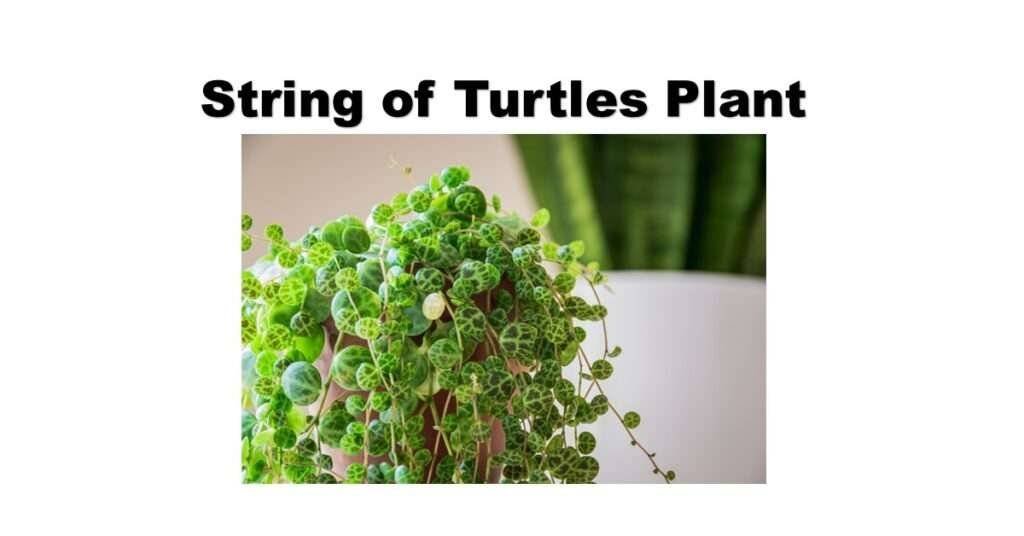
What does it look like?
This type of Peperomia resembles a string of turtles, with its leaves growing crisscrossed along its stems and accented with shades of silvery-green, almost as if they were decorated with a mosaic texture. The exquisitely striped, turtle-like shells are a striking feature in any setting and a welcome change of pace from the typical plants you may be used to.
This plant has more to offer in terms of overall aesthetics than one might first think. Given a trellis or pole to climb, its vines’ pendulous nature provides exquisite cascades from hanging pots or delightful vertical growth. A living example of the beautiful artistry of nature, every leaf has a distinct personality and the potential to expand infinitely.
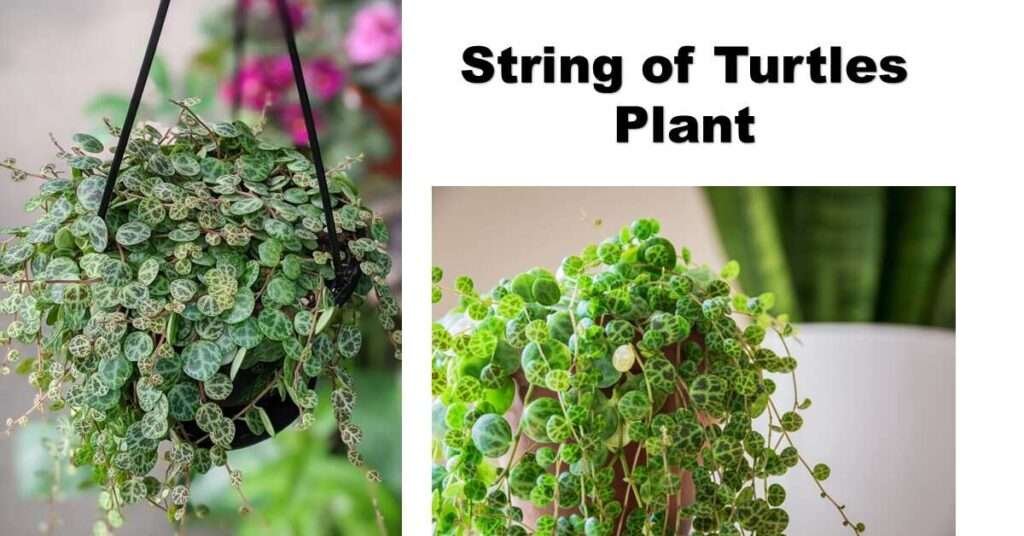
How to Propagate String of Turtles Plant?
You don’t have to buy one to appreciate the beauty of the string of turtle plants. This species is very rewarding to propagate and is also relatively simple. Here’s how to easily add to your collection:
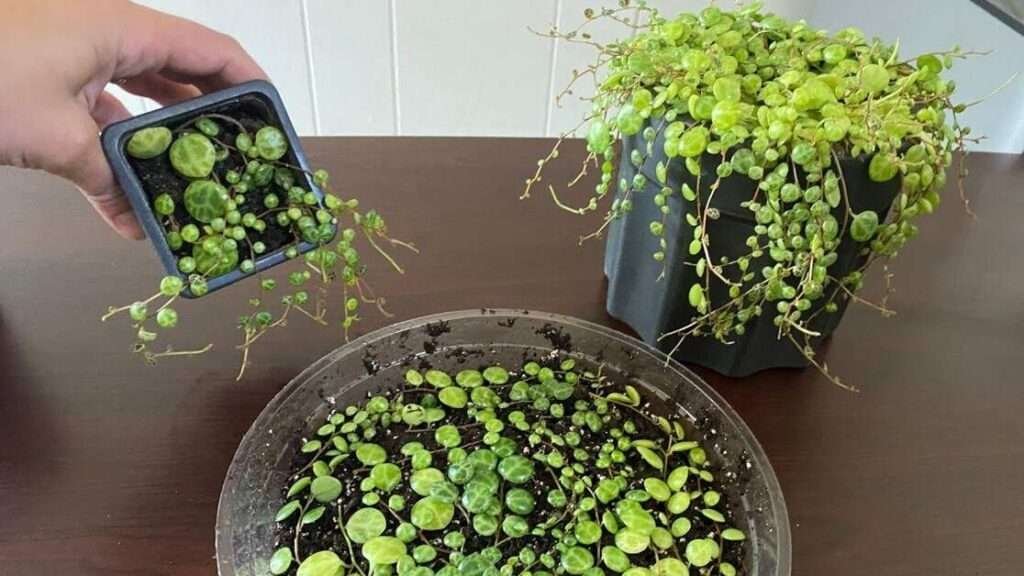
Cuts from leaves
- Pick a leaf that is in good condition off the plant to use as your cutting. Select a leaf with a visible node for optimal outcomes.
- Cut the leaf just below the node. For this purpose, take a sharp knife.
- Cut end a few hours to calluse and dry to avoid decay.
- Plant the cutting, ensuring the cut end is buried just enough to stabilize it in a well-draining soil mixture.
Cuttings from Stems
- Select a healthy stem that has a node and at least one leaf in a similar manner.
- Cut the stem below a node to create a section you can work with.
- After cutting, let the end dry before planting.
- Place the cutting of the stem into damp soil, ensuring the soil is dry.
- The pot should be somewhere sunny and warm but out of direct sunshine. In a few weeks, roots ought to start to take shape.
- The end product is a small group of immature turtles prepared to develop into mature plants.
How to Care String of Turtles Plant?

- Care:
- Good care of this plant involves balancing accuracy and instinct, meeting its requirements and desires.
- Light:
- Indirect bright light is very ideal for this Peperomia type. Although it can withstand reduced light levels, its development can slow down, and its colors might not be as vivid. Steer clear of direct sunlight for extended periods as it may scorch the fragile leaves.
- Soil and Potting:
- For your string of turtle plants, use a well-draining soil mixture. Usually, a mixture of coarse sand, perlite, and peat moss works well, making sure the soil isn’t very dense and damp.
Watering:
The string of turtle plants prefers soil that dries out between waterings. It’s time to water again when the top inch or two of soil feels dry.
Constantly water the plants from the base up to prevent wetting the leaves. While underwatering might result in wilting and unhappy growth, overwatering can cause root rot.
Humidity and Temperature:
Your string of turtle plants should be kept at a temperate room temperature, ideally between 60 and 75 degrees Fahrenheit. It enjoys some humidity, particularly in the summer months when it’s dryer outside. Misting the leaves can replicate its tropical beginnings, but do not overdo it.
The process of fertilization:
Treat your plant with a balanced, water-soluble fertilizer, especially in the summer and spring seasons. Apply the fertilizer in diluted amounts per the package’s directions to prevent nutrient burn caused by overfeeding.
Care:
Because the plant grows relatively slowly, pruning to the string of turtles is usually optional. However, feel free to trim down the stems if you see slight growth or wish to keep the plant in a particular shape. You can share the cuttings with other garden enthusiasts or use them for propagation.
Diseases and Pests:
Look for typical pests affecting houseplants, such as mealybugs or spider mites. Dust accumulation can be avoided, and bugs can be discouraged by wiping the leaves with a moist cloth. If a pest infestation happens, separate the afflicted plant and treat it as directed by the product’s instructions, using horticultural oil or insecticidal soap.
If the soil is overly compacted or the string of turtles plant is overwatered, root rot may also be problematic. If you observe root rot symptoms, such as drooping and browning leaves, the best action is to repot the plant in new, dry soil and cut out the afflicted roots.
Summary
The string of turtles plants invites you to create a living, breathing work of art in your living area rather than just a decorative item to put on show. Every tendril, leaf, and small turtle-like marking on its silvery surface evokes awe and harmony.
Gardeners and plant enthusiasts can bond with this fascinating species by knowing and following its care requirements. A charming exploration of the principles of stewardship and appreciation, tending to the string of turtles plant involves everything from propagation experiments that nurture new life to keeping a healthy atmosphere anchored in gentility.
One leaf, one node, one tendril at a time, watch as a string of turtle plants expands your green universe and tells a singular story of growth and grace. Cheers to your successful gardening! A purpose-driven garden.
Maintaining a string of turtle plants is more than simply keeping it alive; it fosters a lovely piece of nature in your house. Please write your tale and watch it blossom. So go ahead and allow yourself to be enthralled with the lush appeal of these charming vines. This fantastic plant will flourish under your care if you give it some love and care. Plant yours now and watch as they grow more beautiful every day.
FAQs about String of Turtles
1. Is the Plant Known to Be Toxic?
One of its apparent benefits is the non-toxic quality of the string of turtles plant (Peperomia prostrate). Because of this feature, it’s an excellent option for homes with small children or pets. The string of turtle plants is considered benign, unlike many other indoor plants that could be harmful if consumed. Promoting healthy behaviours near plants and discouraging consuming plant material is advisable to avoid allergic responses or upset stomachs.
2. Can a String of Turtles plant be kept indoors?
Peperomia prostrata, the scientific name for the String of Turtles plant, is primarily grown indoors. It is ideal for homes and offices due to its low light tolerance and ability to adapt to indoor surroundings.
The uniqueness of this plant’s string of turtles and low maintenance requirements make it a favorite among lovers of indoor plants. Its favorite indoor spots resemble its natural habitat, which consists of indirect sunshine and a small amount of humidity. These conditions guarantee its healthy growth and the vivid exhibition of its distinctive leaf patterns resembling turtle shells.
3. Do string of turtles grow fast?
The best way to characterize the String of Turtles plant’s growth pace is moderate to slow. Its slower growth rate than other fast-growing houseplants doesn’t make maintenance and care any more complicated, either.
Because of its modest growth rate, the plant will retain its form and beauty for extended periods, eliminating the need for regular trimming or repotting. On the other hand, giving the plant the right amount of light, warmth, and humidity will help it develop more healthily. Patience is essential when growing this unusual plant because its exquisite beauty and minutely detailed leaf patterns are well worth the wait.
4. Why is my String of Turtles losing leaves?
If you observe your String of Turtles plant dropping leaves, assessing the care it receives is essential, as this might be a sign of stress. Overwatering and underwatering are two common causes of leaf loss that can result in problems with the roots and the plant’s incapacity to support its foliage.
In addition, the plant may become stressed by excessive sunshine or low humidity, resulting in the loss of leaves. It’s also essential to look for insect infestations because, among other things, spider mites can seriously harm plants and cause leaf drop. You may assist your plant in recovering and thriving once more by carefully modifying your care regimen to suit its requirements. These include ensuring the soil is well-draining but not dry, keeping humidity at a moderate level, and providing indirect light.
5. Why are my string of Turtles so small?
You should look into a few possible causes if your String of Turtles plants seem more petite than usual. First, think about how much light the plant gets. Although the String of Turtles prefers indirect light, inadequate lighting can stunt its growth and cause smaller leaves and slower development.
Another thing to consider is nutrient availability. Although these plants don’t need a lot of food, they can develop more healthily if they occasionally receive balanced, diluted fertilizer during the growing season. The String of Turtles also grows naturally small and delicately; their beauty is not in size but in each leaf’s minute details. Its moderate to slow growth rate indicates that it takes time to develop fully; thus, patience is also necessary.
6. How do I know if my string of turtles is healthy?
A String of Turtles planted in good health exhibits various vital signals.
- First and foremost, the leaves should resemble the distinctive turtle shell appearance that gives the plant its name: they should be intense, vivid, and densely patterned.
- A rich green colour and a lack of yellowing or wilting in the leaves indicate that the plant is getting enough light and water. In addition, the stems ought to be strong and resilient enough to hold the weight of the leaves without sagging.
- New growth is another sign of health; the presence of budding leaves and tendrils indicates that the plant is in a growing environment.
- Lastly, pristine, spotless leaves that show no signs of illness or pests indicate good health. By looking at these traits, you can determine the
7. Why is my String of Turtles dying?
To identify the reason for any drop in your String of Turtles plant, looking into a few crucial areas is critical. Root rot is one frequent problem that is frequently brought on by overwatering. The plant’s capacity to absorb nutrients and water is hampered by this condition, which causes it to deteriorate.
This may be avoided by ensuring the soil around your plant drains appropriately and letting it dry out a little between waterings. Another problem is temperature stress; these plants prefer warm, steady conditions and can become ill if exposed to extremely low or high temperatures or if drafts drag them around. Ensure your plant is not exposed to direct sunlight since this might blister its leaves and hasten its demise. You can prevent your plant from dying by taking care of these issues and continuing your regular maintenance regimen.
What are the main causes of a string of turtle plant deaths?
Numerous environmental and health-related issues are frequently implicated in turtle fatalities. Because turtles need clean, well-filtered water to prevent infections and illnesses, poor water quality is a major contributing factor. Dietary imbalances deficient in vital vitamins and minerals can cause deficits in some nutrients, which can cause systemic health problems and even death.
Exposure to excessive heat or cold poses a severe risk to turtles, as they are ectothermic, meaning their surroundings determine their body temperature. Moreover, mishaps in their habitat or injuries from contact with other animals can be lethal. Finally, stress resulting from bad handling or overpopulation might impair their immune systems, leaving them more vulnerable to illness. It’s essential to comprehend and reduce these hazards to keep plant healthy.
Does String of Turtles Climb?
Unlike other trailing or climbing plants, the String of Turtles, scientifically known as Peperomia prostrata, is not well-known for its climbing capabilities. Instead, it resembles a trailer or a ground-hugger more. Its stems often grow horizontally parallel to the ground or elegantly dangle over pot rims, producing a beautiful cascade effect. Its trailing habit makes it ideal for tall containers or hanging baskets, allowing its delicate leaf to cascade over the sides and lend a charming element to any area.
But if you give it something to cling to, like a trellis or a little structure, it might utilize that as a foothold and climb a little. However, unlike other climbers, don’t expect it to scale walls or reach high altitudes. It is a subdued, easygoing plant happy to meander at ground level or elegantly cover its surroundings. Therefore, despite not being a climbing champion, it undoubtedly adds a unique beauty to the plant kingdom with its characteristic turtle-patterned leaves and laid-back personality.
